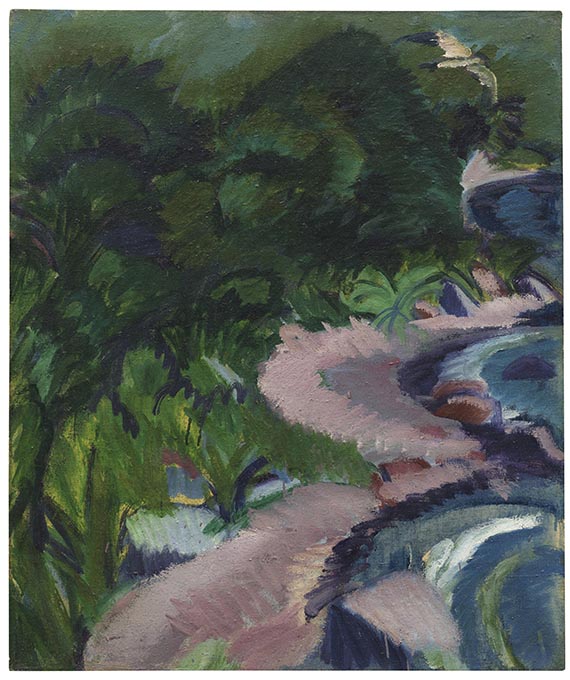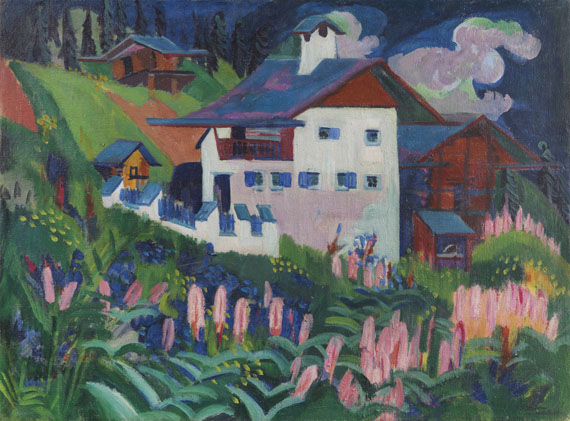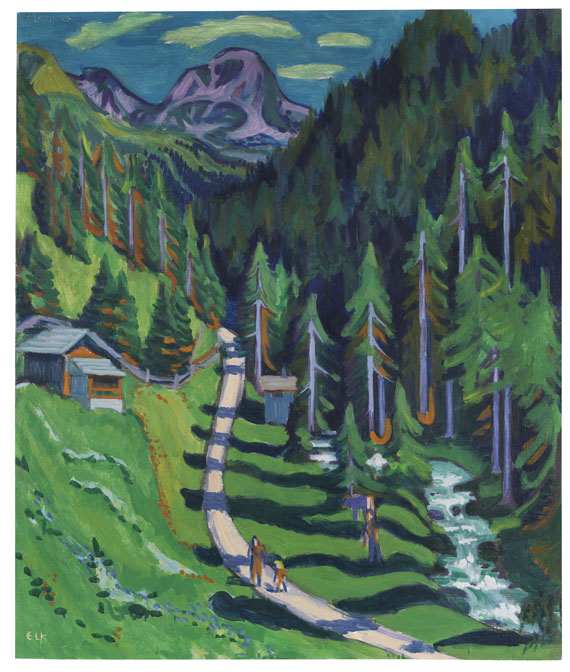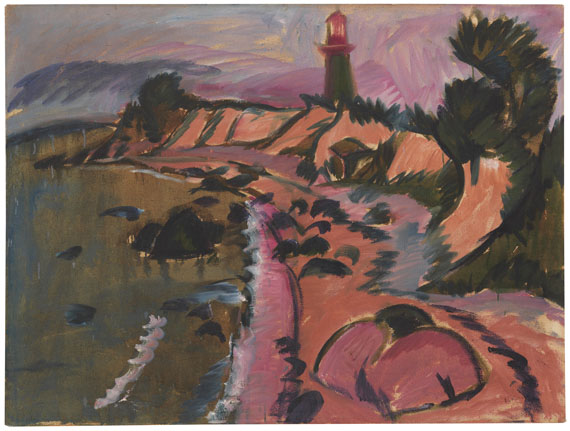Sale: 550 / Evening Sale, June 07. 2024 in Munich  Lot 124000449
Lot 124000449
 Lot 124000449
Lot 124000449
124000449
Ernst Ludwig Kirchner
Fehmarnlandschaft, 1913.
Oil on canvas
Estimate:
€ 300,000 - 400,000
$ 321,000 - 428,000
Information on buyer's premium, taxation and resale right compensation will be available four weeks before the auction.
Fehmarnlandschaft. 1913.
Oil on canvas.
Signed and dated in lower left. 72 x 60.5 cm (28.3 x 23.8 in).
The work is shown in the artist's photo album (photos not in the albums I-IV).
• In the summers of 1912-1914, Kirchner created works characterized by "absolute maturity" on the island of Fehmarn.
• The power of the wild nature inspired Kirchner to create a dynamic painting of a strong immediacy.
• Radical rejection of conventions and habits: a bird's-eye view rendered in a zoom-like format.
• Showing the free forms of the expressive Berlin style.
• His Fehmarn paintings can be found in, among others, the Nationalgalerie Berlin, the Folkwang Museum in Essen, the Städel Museum in Frankfurt am Main, the Kunsthalle Hamburg, the Carnegie Museum of Art in Pittsburgh and the Detroit Institute of Arts.
The work is documented at the Ernst Ludwig Kirchner Archive, Wichtrach/Bern.
PROVENANCE: Dr. phil. Friedrich Isernhagen Collection, Leverkusen/Cologne (1918).
Frankfurter Kunstkabinett Hanna Bekker vom Rath (1964).
Brook Street Gallery, London (1965).
Galerie Roman Norbert Ketterer, Campione d'Italia (1966).
Private collection Switzerland.
Galerie Utermann, Dortmund.
Galerie Thomas, Munich.
Dr. Theo Maier-Mohr Collection (acquired fromt he above in 1985).
Family-owned ever since.
EXHIBITION: Espressionismo Tedesco, Galleria La Nuova Loggia, Bologna 1966 (dated "1912", illu.).
Arbeiten von E. L. Kirchner, Galerie Utermann, Dortmund, Herbst 1985, cat. no. 1 (illu. in color).
LITERATURE: Donald E. Gordon, Ernst Ludwig Kirchner, Munich/Cambridge (MA) 1968, pp. 93 and 321, no. 329 (illu. in black and white).
- -
Frankfurter Kunstkabinett, Frankfurt a. Main, 8th auction, 1964, lot 131 (illu. in color on the cover).
Galerie Roman Norbert Ketterer, Campione d'Italia, Moderne Kunst III, Stuttgart-Bad Canstatt 1966, p. 86, cat. no. 75 (titled "Fehmarnküste m. Möwe" and dated "1912", full-page color illu. on p. 86).
Hans Delfs, Mario-Andreas von Lüttichau and Roland Scotti, Kirchner, Schmidt-Rottluff, Nolde, Nay .. Briefe an den Sammler und Mäzen Carl Hagemann, Ostfildern 2004, nos. 129-132 and 139.
Kunsthaus Lempertz, Cologne, 528th auction, Kunst des XX. Jahrhunderts, November 24, 1972, p. 83, lot 476 (illu. in black and white, plate 6).
Hans Delfs (ed.), Ernst Ludwig Kirchner. Der Gesamte Briefwechsel ("Die absolute Wahrheit, so wie ich sie fühle"), Zürich 2010, nos. 496, 498, 512, 514 and 530.
"Tonight I'm going to Lübeck and from there to Fehmarn to recharge my batteries and to paint."
Ernst Ludwig Kirchner to Gustav Schiefler in early June 1913, quoted from: Wolfgang Henze (ed.), Briefwechsel 1910-1935/1938, Stuttgart/Zürich 1990, letter no. 34, p. 62.
"Dear Mrs. Kirchner, I am pleased to inform you that Kirchner has accepted the bids of my colleagues as well as my own; thus Dr. Clingestein will receive the picture of the 'Blühende Kastanie' (Blossoming Chestnut) for M 500, and Dr. Isernhagen the Fehmarn picture for M 400."
Carl Hagemann to Erna Kirchner, letter from January 25, 1918, quoted from: Hans Delfs et al. (eds.), Kirchner, Schmidt-Rottluff, Nolde, Nay .. Briefe an den Sammler und Mäzen Carl Hagemann, Ostfildern 2004, no. 131.
Oil on canvas.
Signed and dated in lower left. 72 x 60.5 cm (28.3 x 23.8 in).
The work is shown in the artist's photo album (photos not in the albums I-IV).
• In the summers of 1912-1914, Kirchner created works characterized by "absolute maturity" on the island of Fehmarn.
• The power of the wild nature inspired Kirchner to create a dynamic painting of a strong immediacy.
• Radical rejection of conventions and habits: a bird's-eye view rendered in a zoom-like format.
• Showing the free forms of the expressive Berlin style.
• His Fehmarn paintings can be found in, among others, the Nationalgalerie Berlin, the Folkwang Museum in Essen, the Städel Museum in Frankfurt am Main, the Kunsthalle Hamburg, the Carnegie Museum of Art in Pittsburgh and the Detroit Institute of Arts.
The work is documented at the Ernst Ludwig Kirchner Archive, Wichtrach/Bern.
PROVENANCE: Dr. phil. Friedrich Isernhagen Collection, Leverkusen/Cologne (1918).
Frankfurter Kunstkabinett Hanna Bekker vom Rath (1964).
Brook Street Gallery, London (1965).
Galerie Roman Norbert Ketterer, Campione d'Italia (1966).
Private collection Switzerland.
Galerie Utermann, Dortmund.
Galerie Thomas, Munich.
Dr. Theo Maier-Mohr Collection (acquired fromt he above in 1985).
Family-owned ever since.
EXHIBITION: Espressionismo Tedesco, Galleria La Nuova Loggia, Bologna 1966 (dated "1912", illu.).
Arbeiten von E. L. Kirchner, Galerie Utermann, Dortmund, Herbst 1985, cat. no. 1 (illu. in color).
LITERATURE: Donald E. Gordon, Ernst Ludwig Kirchner, Munich/Cambridge (MA) 1968, pp. 93 and 321, no. 329 (illu. in black and white).
- -
Frankfurter Kunstkabinett, Frankfurt a. Main, 8th auction, 1964, lot 131 (illu. in color on the cover).
Galerie Roman Norbert Ketterer, Campione d'Italia, Moderne Kunst III, Stuttgart-Bad Canstatt 1966, p. 86, cat. no. 75 (titled "Fehmarnküste m. Möwe" and dated "1912", full-page color illu. on p. 86).
Hans Delfs, Mario-Andreas von Lüttichau and Roland Scotti, Kirchner, Schmidt-Rottluff, Nolde, Nay .. Briefe an den Sammler und Mäzen Carl Hagemann, Ostfildern 2004, nos. 129-132 and 139.
Kunsthaus Lempertz, Cologne, 528th auction, Kunst des XX. Jahrhunderts, November 24, 1972, p. 83, lot 476 (illu. in black and white, plate 6).
Hans Delfs (ed.), Ernst Ludwig Kirchner. Der Gesamte Briefwechsel ("Die absolute Wahrheit, so wie ich sie fühle"), Zürich 2010, nos. 496, 498, 512, 514 and 530.
"Tonight I'm going to Lübeck and from there to Fehmarn to recharge my batteries and to paint."
Ernst Ludwig Kirchner to Gustav Schiefler in early June 1913, quoted from: Wolfgang Henze (ed.), Briefwechsel 1910-1935/1938, Stuttgart/Zürich 1990, letter no. 34, p. 62.
"Dear Mrs. Kirchner, I am pleased to inform you that Kirchner has accepted the bids of my colleagues as well as my own; thus Dr. Clingestein will receive the picture of the 'Blühende Kastanie' (Blossoming Chestnut) for M 500, and Dr. Isernhagen the Fehmarn picture for M 400."
Carl Hagemann to Erna Kirchner, letter from January 25, 1918, quoted from: Hans Delfs et al. (eds.), Kirchner, Schmidt-Rottluff, Nolde, Nay .. Briefe an den Sammler und Mäzen Carl Hagemann, Ostfildern 2004, no. 131.
E. L. Kirchner's arcadia. Retreat from the big city
"Tonight I am going to Lübeck and from there to Fehmarn to recharge my batteries and to paint", Ernst Ludwig Kirchner wrote to the Hamburg art collector Gustav Schiefler, his close confidant and author of the first catalogue raisonné of his prints, in early June 1913, the year the present work was created (quoted from: Wolfgang Henze (ed.), Briefwechsel 1910-1935/1938, Stuttgart/Zurich 1990, letter no. 34, p. 62).
E. L. Kirchner and his fellow artists (including Erich Heckel and Karl Schmidt-Rottluff) discovered the Moritzburg ponds near Dresden as their common summer retreat in the early 'Brücke' years from 1905. During the Berlin years between 1911 and 1917, which also saw the creation of the work offered here, E. L. Kirchner was particularly drawn to the Baltic coast, which he regarded as his 'Arcadia' far away from Berlin, and which proved to be a particularly important source of inspiration in the following years. Escaping the noisy, hectic and anonymous city of Berlin on his quest for the greatest possible originality, the artist found the desired unity of art and nature on the Baltic coast and enjoyed a simple and quiet life.
In 1908, Kirchner traveled to the beautiful Baltic Sea island of Fehmarn for the first time. The landscape with its steep cliffs and beautiful sandy beaches, the sound of the at times rough sea with high waves and foaming spray, the carefree life of men and women bathing in the sea, the vast horizon, the unique vegetation with its silver poplars, willows and dune grass - all of this was profoundly inspiring. "Unfortunately, unfortunately we have to go back soon. You wouldn't believe how hard that is for us. I don't know whether the sea is most beautiful in summer or in fall. I paint as much as I can to carry at least some of the thousand things I want to paint with me," Kirchner wrote in a letter to his student and fellow painter Hans Gewecke in 1913, the year our painting was created. (September 24, 1913, letter no. 193, in: Sketchbook no. 35, Kirchner Museum Davos)
Coast, beach and sea. Picturesque Fehmarn
In the summer of 1913, Erna Schilling accompanied Kirchner to Fehmarn like she already had a year earlier, when he had met her at a dance hall in Berlin. During these summer months, they lived together in the south-east part of the island, in the house of the lighthouse keeper Lüthmann on "Staberhuk". The nearest farm was about two kilometers away, and it was ten kilometers to the closest village. Kirchner thus spent most of his time outdoors, bathing, swimming, walking and painting on the beach or on the cliffs - the same place where this work was created. From an almost unnaturally elevated position and in a reduced yet expressive color scheme, the artist makes the coast, the rose-colored beach, the blue sea crowned with light spray and the strong green, untamed vegetation the central motif of his depiction. However, in contrast to traditional and contemporary landscape painting, he did not depict the vastness of the sea or the picturesque view over the coastal landscape. Instead, Kirchner abstracted nature, reducing the sea to small semi-circular shapes by radically cropping the picture, the curves of which he repeated in the sandy beach in pink and violet. He dissolved the vegetation into rounded, free forms and energetically placed brushstrokes which cover almost the entire remaining surface. High above the scene, a seagull in free flight breaks through the density and narrowness of the depiction and evokes a sense of airiness.
In an essay about his creative output at the time, the artist later noted in retrospect: "From 1912 to 1914, I spent the summer months on Fehmarn with Erna. Here I learned to shape the final unity of man and nature and completed what I had begun in Moritzburg. The colors became milder and richer, the forms stricter and more distant from their natural appearance." (E. L. Kirchner, in: Eberhard W. Kornfeld, Ernst Ludwig Kirchner. Nachzeichnung seines Lebens, ex. cat. Basel 1979, p. 337). After the outstanding creative summer of 1913, the year our painting was created, Kirchner visited the island again the following year, but had to leave early as Fehmarn had been declared a restricted military area due to the outbreak of the First World War. The artist would never return to the island.
At the height of his artistic development
Kirchner captured his immediate surroundings on Fehmarn with an impressive creative power, the motifs of which he now incorporated into his very own expressionist pictorial vocabulary. Most of the works were created directly on the island; only very few are later works from his Berlin studio. The playful lightness of the earlier works made at the Moritzburg Ponds during the Dresden "Brücke" years gives way to a more mature, harsher, more rhythmic and hatched brushwork in the Fehmarn paintings: "The paintings from 1913 and 1914 are reminiscent of feathers, a sequence of fanned-out, dense brushstrokes that fill the entire surface." (Lucius Grisebach, Ernst Ludwig Kirchner 1880-1938, Cologne 1999, pp. 95f.)
In these years before the First World War, the motifs of the "Brücke" artists, and especially those of E. L. Kirchner, were centered on two almost contradictory themes: the big city and its people after the turn of the century, which Kirchner portrayed in his well-known "Street Scenes", on the one hand, and landscapes characterized by the unity of man and nature, on the other. Hence, his artistic work follows a rhythm between city and country life, defined by both a culture of pleasure as well as a yearning for nature - nightclubs and cliffs. According to Dr. Wolfgang Henze, director of the E. L. Kirchner Archive, "the works Kirchner made on Fehmarn are equal in scope and significance to those created in Berlin at the same time [and they are] complementary" (ex. cat. E. L. Kirchner. Eine Ausstellung zum 60. Todestag, Kunstforum Wien, 1998, p. 41).
Indeed, with "Fehmarn Landschaft", Kirchner took an intense approach that is rarely found in works from these years: Color and form gradually break away from the figurative motif and attain an unrestrained painting style. He countered visual habits shaped by Romanticist landscapes with a reduced palette, simplified forms, bold and expressive brushstrokes and a highly unconventional perspective, and thus with a profoundly modern pictorial language. [CH]
124000449
Ernst Ludwig Kirchner
Fehmarnlandschaft, 1913.
Oil on canvas
Estimate:
€ 300,000 - 400,000
$ 321,000 - 428,000
Information on buyer's premium, taxation and resale right compensation will be available four weeks before the auction.








